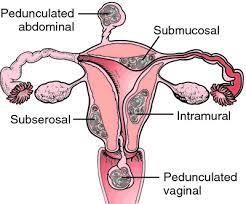A 40-year-old female presents with cramping and excessive vaginal bleeding. Ultrasound reveals benign uterine tumors in the smooth muscle cells of the myometrium. These tumors are commonly called:
adenomas
leiomyomas
endometriosis.
adenomyosis
The Correct Answer is B
Choice A rationale: Adenomas are benign tumors that originate from glandular tissue, such as the endometrium, the inner lining of the uterus.
Choice B rationale: Leiomyomas, also known as fibroids, are benign tumors that arise from the smooth muscle cells of the myometrium, the middle layer of the uterine wall. They are the most common type of uterine tumors, affecting up to 80% of women by age 50. They can cause symptoms such as heavy menstrual bleeding, pelvic pain, pressure, and infertility.
Choice C rationale: Endometriosis is a condition where endometrial tissue grows outside the uterus, causing inflammation and pain.
Choice D rationale: Adenomyosis is a condition where endometrial tissue invades the myometrium, causing enlargement and distortion of the uterus.

Nursing Test Bank
Naxlex Comprehensive Predictor Exams
Related Questions
Correct Answer is A
Explanation
Choice A rationale: An allergy to sulfa drugs is important as some diabetes medications, like sulfonylureas, contain components related to sulfa drugs, which could cause an allergic reaction in susceptible individuals.
Choice B rationale: Smoking cessation and lifestyle history are important but might not directly impact initial diabetes treatment options.
Choice C rationale: Numbness in the soles of the feet might indicate neuropathy, a common complication of diabetes, but is not directly related to the choice of initial treatment.
Choice D rationale: While obesity is a risk factor for Type 2 diabetes, it's less critical for immediate treatment decisions compared to drug allergies that could impact medication choices.
Correct Answer is A
Explanation
Choice A rationale: These lab findings, particularly concentrated urine (high specific gravity) and hyponatremia, are consistent with SIADH, where excessive ADH secretion leads to water retention and dilutional hyponatremia.
Choice B rationale: While it can affect sodium levels, Cushing's syndrome typically results in hypernatremia or normal sodium levels rather than hyponatremia.
Choice C rationale: Usually presents with hyponatremia but not specifically with high urine specific gravity or hematocrit.
Choice D rationale: DI is associated with high serum sodium and low urine specific gravity due to excessive excretion of dilute urine.
Whether you are a student looking to ace your exams or a practicing nurse seeking to enhance your expertise , our nursing education contents will empower you with the confidence and competence to make a difference in the lives of patients and become a respected leader in the healthcare field.
Visit Naxlex, invest in your future and unlock endless possibilities with our unparalleled nursing education contents today
Report Wrong Answer on the Current Question
Do you disagree with the answer? If yes, what is your expected answer? Explain.
Kindly be descriptive with the issue you are facing.
